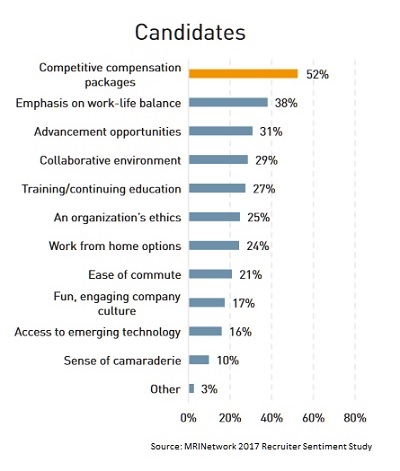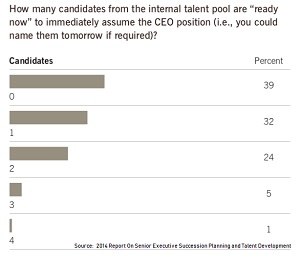In general, when companies are looking to bring on new talent, they often promote the fact that there are opportunities for career growth within their company. In fact, according to a 2017 report by MRI Network, this is a quality that recruiters agree is highly attractive to prospective new hires.
And, of course, they are correct. The same study found that the chance for advancement makes the top three most important factors for job seekers.
But, sadly, this promise is often going unfulfilled.
According to this same report, among the reasons businesses were hiring last year was to fill newly created positions, as well as vacancies from resignations and retirements. This suggests that many businesses are bringing in outside candidates rather than filling those openings with internal talent.
With a strong, effective succession management plan in place, some, perhaps many, of the openings could be filled internally. Yet two-thirds of businesses within the US do not have a definite succession system for their leadership, let alone for other positions.
Take a look at your current team. If a leader in your company had to step down or decided to retire, is there a person within your organization who could step into their place? Are there current employees who possess the skills or potential to fill newly created jobs or step into another role as your business grows?
If your HR department is not able to provide an answer to these questions, it is time to start planning.
Here are four ways to get started.
1. Recognize and identify obstacles
In order to find a solution, you must first understand what is standing in the way of success. Whether your team has tried to come up with a strategy for succession in the past or it is just now trying to create one, it is important to understand why it is necessary and what current practices could inhibit its effectiveness.
 One of the most common reasons why a business is uncertain about succession is that no potential leaders are evident or have been identified in the current workforce.
One of the most common reasons why a business is uncertain about succession is that no potential leaders are evident or have been identified in the current workforce.
A Stanford report on succession planning found that many businesses struggled to create a definite plan due to the lack of available talent within their organization. Only about half these organizations had a specific executive in mind who was being trained for a higher position; 39% of companies said that there were no employees who currently had the skills necessary to take on these roles.
This is a statistic that should scare HR teams. After all, they are the ones responsible for finding qualified talent for the organization. Therefore, their current recruiting and hiring practices are standing in the way of succession and must be re-evaluated.
Of course, the obstacles will be different for each organization. Perhaps the issue is that your business is lucky enough to have plenty of prospects and your decision-makers cannot come to a unified conclusion. Perhaps the direction of your business has changed and priorities have shifted.
Whatever the challenge is, the important part is acknowledging what the issue is first before coming up with a solution.
2. Make the process highly transparent
In general, employees do not always find their employers to be trustworthy and transparent about their future plans. According to Edelman’s trust report, one-third of workers do not trust their organization, and two-thirds believe that current leadership is not looking ahead at the bigger picture. Obviously, this can lead to major issues within the workplace, including disengagement and potentially higher turnover.
There is no need for secrecy in succession management. In fact, keeping your employees in the dark about who has the potential for leadership within the organization could hurt internal growth. According to a poll, the number one reason why workers leave their job is because they found career advancement in another organization that was not offered with current employer. But, how disappointing would it be if they were supposed to advance but had no idea that this opportunity was going to come their way?
In order to avoid this, HR teams should embrace transparency with succession management. This can be done by hosting regular meetings with both upper-level team members to discuss strategies and plans for succession. Studies have found that when businesses are more open and transparent about their strategies, it cultivates trust within the workplace, which can directly improve employee performance and internal engagement rates.
3. Be sure the necessary resources are in place
If your business is planning to train internal talent to take over higher roles, then part of your succession management plan must include strategies to make this happen. Be aware that the training processes can be very lengthy and complex, especially if you are training an executive to take over a high-level position, such as CEO.
Sadly, the majority of organizations are failing in this department as well. Although 89% of business executives agree that a top priority of theirs is to improve internal leadership and skills, by one account 56% of HR leaders say they aren’t doing enough to increase employee training opportunities.
Numbers like this simply won’t cut it for a business that is looking to train their future leaders. Therefore, your HR department should provide the opportunity for them to learn and practice the skills that will be necessary for their future. If your business is planning on promoting internally, then the proper training courses and opportunities must be in place, such as access to classes, certification, mentorship, and so on.
4. Be ready for constant re-evaluation
The priorities and needs of your business will change over time, especially as a small, growing organization. Therefore, your succession strategy should not be set in absolute stone. Adjustments will need to be made as new talent comes along or as things change in the market.
As an HR department that is committed to implementing a successful succession plan, your team must always be looking for ways to improve.
- Has your team actually been training your employees properly for their future in the company?
- Are your potential leaders meeting regularly to discuss their performance and ways that they can improve and grow?
- Are there new team members that show potential for higher positions?
Just like with any business plan or campaign strategy, sticking steadfast to the plan could actually end up holding your business back from greater opportunities along the way. Be sure that your HR team regularly evaluates its progression and implementation of succession strategies.
Conclusion
Growth and success in a business does not happen by accident; it is a result of careful planning, strategy, and execution. Therefore, it is unwise for companies to not plan for future growth. While your current leaders may be doing a fantastic job, they will not be running the business forever, so your organization must have a plan in place to ensure that it can always rely on a qualified leader, no matter what happens.
